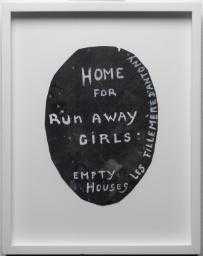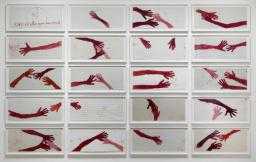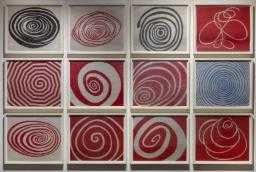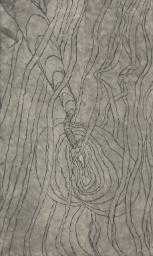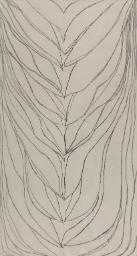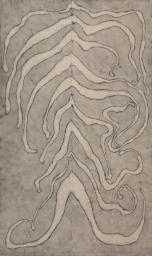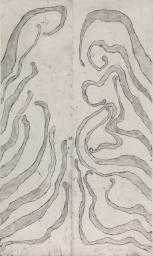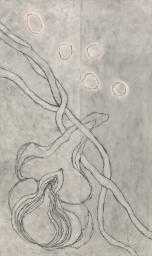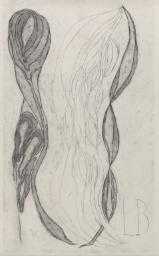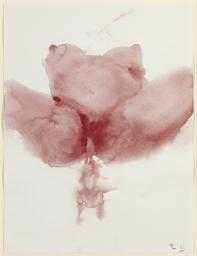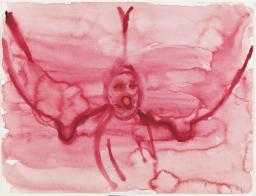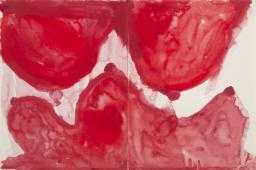
Not on display
- Artist
- Louise Bourgeois 1911–2010
- Medium
- 16 etchings with watercolour, gouache, graphite, coloured pencil and ink on paper
- Dimensions
- Image, each: 1016 × 1524 mm
frame: each: 1190 × 1700 × 68 mm (unconfirmed) - Collection
- ARTIST ROOMS
Tate and National Galleries of Scotland. Lent by Artist Rooms Foundation 2013
On long term loan - Reference
- AL00357
Summary
À L’Infini is a series of sixteen large works on paper, framed and arranged in grid. Each sheet has the same printed image of two intersecting tube-like lines as a base, which Bourgeois added to with pencil and gouache washes. On some sheets there are traces of words written in pencil. On other sheets there are depictions of the female body, couples, childbirth, disembodied limbs and body parts, among other elements like coils, spirals, tubes and flower buds. These elements merge and intersect with the spiralling lines snaking across the paper on a diagonal. The lines and shapes are coloured various shades of red, pink and white. It was completed between 2008 and 2009 when the artist was 97 years of age, with the assistance of her longtime assistant, friend and collaborator Jerry Gorovoy. Curator Lucy Askew has argued that this work reflects the themes and concerns that the artist explored throughout her long career (Askew and d’Offay 2013, p.36).
The French title of the work, ‘À L’Infini’, translated as ‘into infinity’, is suggestive of both an unmapped expanse and a life cycle. This idea is borne out by the evocation of bodily forms across the series, which range from full figures to body parts as well as more abstract shapes and textures evocative of internal organs. The diagonal lines crossing each sheet are reminiscent of veins or arteries and splotches of red and pink paint could be read as drips and splashes of blood. In this way the work might seem to suggest the fallibility of the body, with the infinity of the title referring to an experience after death. On the other hand, it might imply the continuation of life through family and reproduction as well as the artist’s body of work. Askew has also read the spirals of À L’Infini as symbolic of veins, umbilical cords and even of the double helix structure of DNA, the substance of which life is made. She writes:
Bourgeois’s drawings in pencil and red paint expand and reconfigure the printed lines which recede against a dance of knots and spirals, blood-filled arteries and veins, umbilical cords, meandering rivers, threads and tubes, notations and indistinct texts, floating figures and bulbous, anatomical shapes.
(Askew and d’Offay 2013, p.24.)
The artist’s use of red in À L’Infini is characteristic of her work on paper. Bourgeois stated: ‘Red is an affirmation at any cost – regardless of the dangers in fighting – of contradiction, of aggression. It’s symbolic of the intensity of the emotions involved.’ (Quoted in Askew and d’Offay 2013, p.85.) The colour appeals to the motifs connecting the different sheets in the series, which look like veins and arteries in the body or the blood lines of a family.
The spiralling line is a symbol that features prominently in Bourgeois’s work, especially as a means to represent reproduction. In her sculpture Nature Study 1986 (Tate AL00228) a hand also appears from within a spiral to cradle a female figure, representing the cyclical nature of motherhood and childbirth. This same, cyclical relationship is apparent in À L’Infini, with its depictions of the female figure hanging in space, a male and female couple embracing and infant figures suspended in womb-like sacks. Despite representing different stages in a life cycle, the work does not follow a straightforward narrative. Instead episodes cross over, intersect and are repeated and perspectives shift from bodies and limbs to microscopic shapes and textures. In this way À L’Infini combines the monumental with the everyday, presenting an intimate view in large scale.
Further reading
Paul Gardner, Louise Bourgeois, New York 1994.
Mignon Nixon, Fantastic Reality: Louise Bourgeois and a Story of Modern Art, Cambridge, Massachusetts, and London 2005.
Lucy Askew and Anthony d’Offay, Louise Bourgeois: A Woman without Secrets, exhibition catalogue, National Galleries of Scotland, Edinburgh 2013, pp.76–95, reproduced pp.28–9, 68–9, 77, 95.
Allan Madden
The University of Edinburgh
January 2015
The University of Edinburgh is a research partner of ARTIST ROOMS.
Does this text contain inaccurate information or language that you feel we should improve or change? We would like to hear from you.
Display caption
The title of this large scale, multi-part drawing translates as ‘into infinity’ or ‘ad infinitum’. Each sheet contains the image of ribbons that weave around each other and flow diagonally across the page. Suggestive of blood-filled arteries, umbilical cords, rivers, threads or tubes, the drawings remind us of the basic elements of life and its complex journey through time.
Gallery label, October 2016
Does this text contain inaccurate information or language that you feel we should improve or change? We would like to hear from you.
You might like
-
Louise Bourgeois Home for Runaway Girls
1994 -
Louise Bourgeois 10 am is When You Come to Me
2006 -
Louise Bourgeois Spirals
2005 -
Louise Bourgeois Femme
2007 -
Louise Bourgeois The Nest
2009 -
Louise Bourgeois Look Up!
2009 -
Louise Bourgeois The Smell of Eucalyptus (#2)
2006 -
Louise Bourgeois Are You In Orbit? (#1)
2007 -
Louise Bourgeois Are You In Orbit? (#2)
2007 -
Louise Bourgeois Love and Kisses
2007 -
Louise Bourgeois The Unfolding
2007 -
Louise Bourgeois The Birth
2007 -
Louise Bourgeois The Feeding
2007 -
Louise Bourgeois The Family
2008 -
Louise Bourgeois The Friendly Landscape
2008

